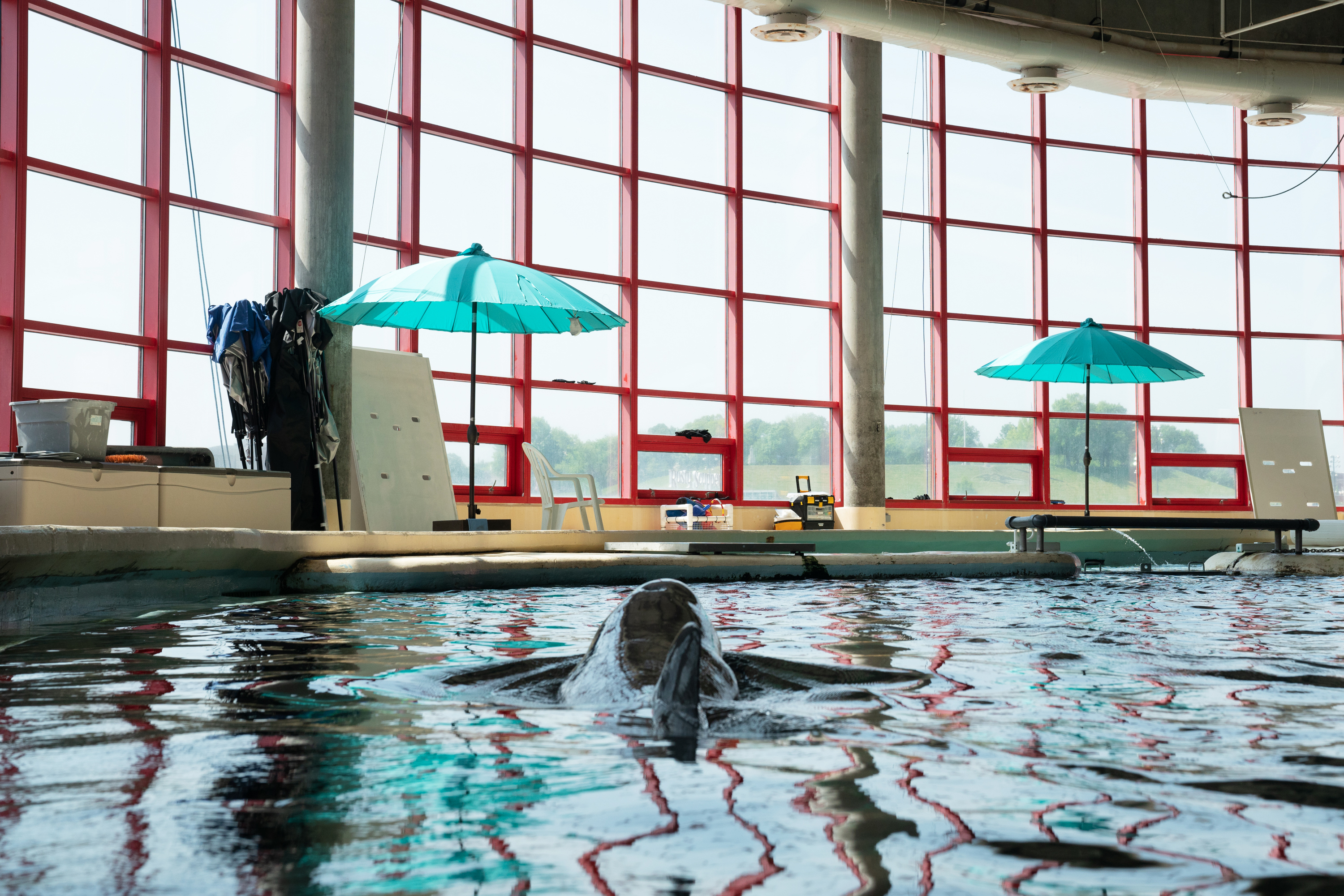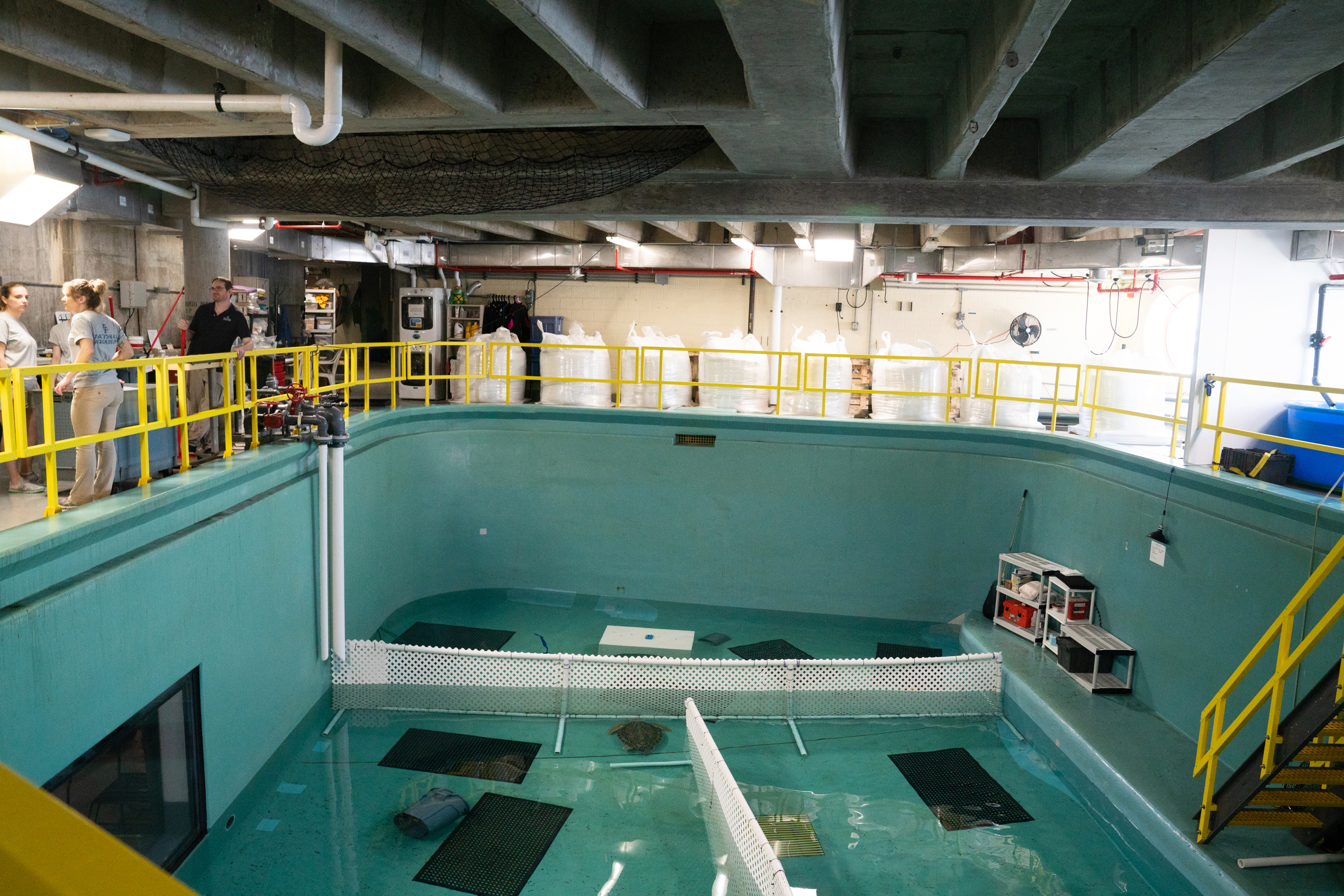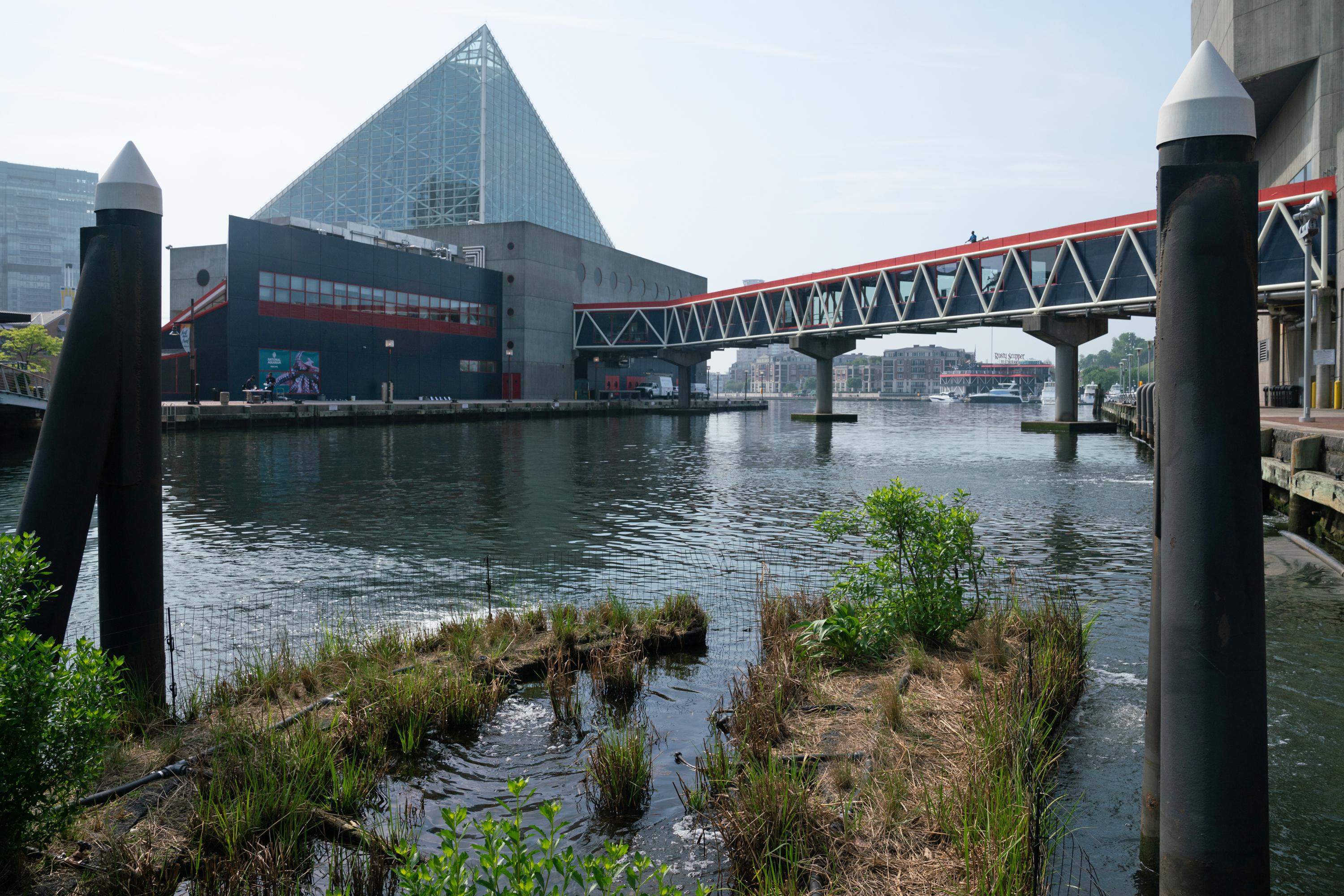At Baltimore’s National Aquarium, climate change presents challenges inside and out
By LOURDES GARCIA-NAVARRO & DANA CRONIN

Three years ago, the National Aquarium in Baltimore made a big announcement. After a public backlash against marine animal parks brought on by the documentary Blackfish, the aquarium decided to move its prized pod of dolphins to a first-of-its-kind sanctuary.
They set a 2020 deadline to find the perfect spot either off the coast of Florida or in the Caribbean — one where the water is warm, the area is protected and the climate is calm.
But now, that 2020 move is no longer realistic, according to John Racanelli, the aquarium’s CEO. And that’s due in large part to a factor beyond its control: climate change.
Of the more than 50 sites the aquarium has surveyed, so far not one has been deemed safe enough from things like fierce storms and algal blooms, both projected to worsen as temperatures rise.


The umbrellas near the National Aquarium’s dolphin tanks are meant to prepare the animals for what life will eventually be like in an open air sanctuary.CLAIRE HARBAGE / NPR
“There’s big pieces of it that you just can’t predict,” says Leigh Clayton, vice president of animal care and welfare at the aquarium. “We’re looking at precedents. How often do areas get hit by hurricanes, where do the hurricanes tend to go to land, what has historical damage been?”
“The reality is we really don’t know,” Clayton says. “We’re all just figuring this out.”
And it’s not just a problem for the aquarium’s dolphins. Below the dolphin arena is the turtle rehabilitation center, essentially a triage site for so-called “cold-stunned” turtles. These are sea turtles that have been suddenly exposed to water so cold, their systems effectively shut down.
The aquarium has seen more and more of these sick turtles over the years. With warming waters, says Racanelli, sea turtles are venturing further north and winding up in areas that experience more brutal cold snaps. Sea turtles that follow the Gulf Stream, for example, are now ending up trapped in the hook of Cape Cod, which is where most of the aquarium’s recovering turtles come from.


The aquarium rescues sea turtles that get stuck and injured in and around Cape Cod, Mass.CLAIRE HARBAGE / NPR
Outside of the aquarium, climate change has introduced an entirely separate set of challenges for Racanelli and his staff. With its prime location right on Baltimore’s inner harbor, the aquarium is projected to face near-daily flooding by the end of the century. Last year, the city filed a lawsuitagainst 26 fossil fuel companies seeking compensation for the effects of climate change, including sea level rise and storm surges.
The issues facing the aquarium — and the city more broadly — add to the myriad ways that climate change is reshaping life in communities across the country. As part of an ongoing series on how Americans have begun to adapt, NPR has been traveling the East Coast, hearing from Miami residents worried about the climate’s impact on gentrification; doctors who are concerned about what a warming planet will mean for their patients; and developers and property owners who are increasingly focused on guarding against rising seas.
The aquarium is among those property owners assessing how their building might fare in the future. To address rising sea levels, they have built a prototype of a floating wetland that sits in the harbor and is designed to help protect against storm surges.


The aquarium has constructed a prototype of a floating wetlands in the harbor outside the building which is designed to help protect against storm surges.CLAIRE HARBAGE / NPR
The 400-square-foot patch of vegetation is also designed with the local ecosystem in mind. Built-in pipes help to aerate the water, and aquarium officials say it provides a better habitat for animals than other flood mitigation tools, like concrete sea walls.
“What we really want is diversity, and the wetland does that,” says Charmaine Dahlenburg, the director of field conservation at the National Aquarium. “It has microhabitats, so there’s going to be different types of animals that stop by,” she says.
The aquarium hopes to raise enough money to eventually roll out 14,000 square feet of floating wetland, including docks for visitors to see it up close.
The aquarium sees over a million visitors each year, which, according to Racanelli, gives them a unique platform to engage with and inform guests.
“It’s become an emerging role for aquariums throughout the country and throughout the world to help people better understand some of the big issues that are facing us,” he says.
Educators at the museum talk explicitly with visitors about climate change and ways they can reduce their impact on the environment.
“It’s not a looming threat. It’s a present reality,” says Racanelli. “Whether it’s where we place our dolphin sanctuary, how we evolve here on our inner harbor location in Baltimore … there are steps that we can take and we have to take them. Not soon but now.”
Copyright 2019 NPR. To see more, visit https://www.npr.org.
9(MDA3NzMxMTkxMDEzMDkyOTU3ODRmYjc2Mg001))
9(MDA3NzMxMTkxMDEzMDkyOTU3ODRmYjc2Mg001))


Visitors watch creatures swim inside the aquarium including Calypso, a three-legged green sea turtle.CLAIRE HARBAGE / NPR
LULU GARCIA-NAVARRO, HOST:
In our ongoing series on how the East Coast is adapting to climate change, we traveled this past week to the National Aquarium in Baltimore. This institution is facing multiple climate change-related challenges, both outside and inside the building.
(CHEERING)
GARCIA-NAVARRO: Yes, I’m at the dolphin show, but it’s changed over the years. There’s no disco music, no synchronized jumping. It’s mostly educational now.
UNIDENTIFIED PERSON #1: Dolphins need to be physically fit, like us. How do we accomplish that goal? Exercise.
GARCIA-NAVARRO: Then Dr. Leigh Clayton introduces me to the Atlantic bottlenose pod.
LEIGH CLAYTON: Jade is the mom of Foster, who is one of our males. And then Chesapeake and Spirit and Maya…
GARCIA-NAVARRO: She’s the head of animal care and welfare at the aquarium. And she says they’ve decided to relocate the pod to give them a better life outside in their native habitat. The dolphins will still be in a controlled environment, but one that is better for them.
CLAYTON: It really kind of takes the pressure off of us to create intellectually stimulating and physically stimulating environments for them and allows the natural habitat to do that.
GARCIA-NAVARRO: So like many retirees, the pod is going to Florida, which is where the Atlantic bottlenose dolphin is originally from. At least that’s the plan. But the aquarium has hit some snags. One of the issues is climate change. It’s creating bigger, more powerful storms. So they’ve been doing some modeling to see where the safest place for the new enclosure will be.
CLAYTON: How often do areas get hit by hurricanes? Where do the hurricanes tend to go to land? What has historical damage been? But we also need to keep in mind that there are some factors that may change, and we just can’t predict them.
GARCIA-NAVARRO: That’s the wider issue with climate change. It’s hard to make the right decision when you can’t exactly calculate the effects. And while they’re letting go of the dolphins, they’re taking in more sea turtles.
(SOUNDBITE OF METAL CLANGING)
GARCIA-NAVARRO: We go down stairs behind the dolphin arena to what looks like a deep indoor swimming pool.
CLAYTON: So this is our sea turtle rehabilitation area. You can…
GARCIA-NAVARRO: Inside the pool are a few turtles, numbers on their backs, wading slowly through the shallow pools. Here, they care for what are called cold-stunned turtles – turtles that have been suddenly exposed to water so cold, they get really sick.
CLAYTON: They kind of shut down. They can’t swim. They don’t metabolize properly. They’re more likely to get infections – things like that.
GARCIA-NAVARRO: The aquarium has seen more and more cold-stunned turtles recently. Clayton says climate change is a likely factor, with sudden changes in the water.
CLAYTON: When we’ve got nice, warm temperatures, and then the temperature drops very suddenly, that can catch the turtles unaware.
GARCIA-NAVARRO: It’s another way in which the aquarium and its resources are having to adapt to climate change.
Outside, another experiment in mitigation is underway. The aquarium sits right on Baltimore’s Inner Harbor, a bustling area with shops and restaurants, and with water lapping just a few feet from the aquarium’s doors. Studies show that the Inner Harbor is likely to flood almost daily due to sea level rise by the end of the century.
CHARMAINE DAHLENBURG: You’re welcome to come out…
UNIDENTIFIED PERSON #2: Great.
DAHLENBURG: …To get a better look.
GARCIA-NAVARRO: Charmaine Dahlenburg is the director of field conservation at the aquarium. She’s standing beside what’s called a floating wetland. It’s a 400-square-foot prototype, a floating patch of marsh grasses and plants. And underneath are pipes that aerate the water. The aquarium’s plan is for more artificial wetlands to fill the harbor around the building.
DAHLENBURG: So they prevent flooding. They lessen the effects of harmful algal blooms. And – but they’re also really good carbon sinks.
GARCIA-NAVARRO: Besides absorbing carbon dioxide, these floating green patches help remove pollution from the water while also providing habitat to animals above and below the surface.
Is it better to have something like this than a seawall, for example?
DAHLENBURG: It is better. I mean, the seawall does provide some habitat, so you’ll get your mussels, your crabs. But what we really want is diversity. We really – diversity in any kind of environment is so important, and the wetland does that.
GARCIA-NAVARRO: Meanwhile, the mission of this aquarium has also been changing. Over a million people visit the National Aquarium each year. Megan Anderson does guest outreach here, which since 2012 includes talking about climate change. We met her near the shark exhibit. She says there is a reason they feel they can make a difference.
MEGAN ANDERSON: Aquariums and zoos speak to more people than all sporting events combined. And then people, generally, that come to aquariums and zoos are coming because they do have kind of a love or a passion for the environment.
GARCIA-NAVARRO: She says the facts don’t get people to act on climate change, in her experience. It’s the emotional appeal and giving people a sense of what they can practically do at home.
ANDERSON: Washing your clothes in cold water, talking to friends and family about climate change.
GARCIA-NAVARRO: It’s a message that resonates with Sadie Fernandes, who is at the aquarium with her 2-year-old, Josie.
What do you know about climate change? And are you interested in learning about it when you’re here?
SADIE FERNANDES: Absolutely.
GARCIA-NAVARRO: Yeah?
FERNANDES: I know climate change is real. I know we do need to do better in the environment to make sure everything is sustainable for the next generation.
GARCIA-NAVARRO: And Megan Anderson says she’s seeing more people like Sadie and Josie, who are engaged in this issue.
Back with the animals, head vet Dr. Leigh Clayton says people’s changing attitudes are giving her hope.
CLAYTON: We as humans – our behavior – our behavior changes will absolutely help and make a difference. And the dialogue can be very, very depressing. But when we don’t pollute as much, species come back. Humans get healthier. So it does make a difference.
GARCIA-NAVARRO: She says the next 10 years will be crucial in the fight against climate change, and we all have to do our part.
(SOUNDBITE OF MUSIC) Transcript provided by NPR, Copyright NPR.
For more on this story and audio go to: https://www.kcbx.org/post/baltimore-aquarium-climate-change-presents-challenges-both-inside-and-out#stream/0





